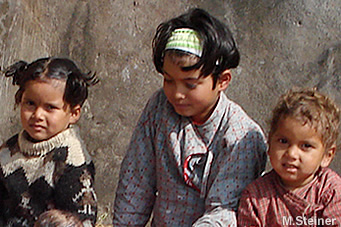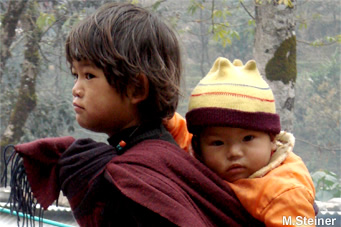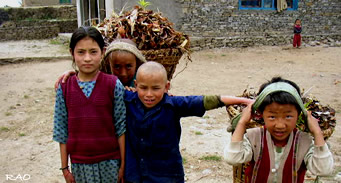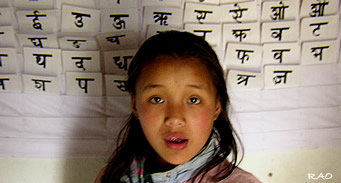|
Education
in Nepal: Reports
|
 |
Nepal EDUCATION |
|
|
 |
|
Hunger
in west causes children to drop out of school
|
 |
TAPRI,
9 January 2008 (IRIN)
Hunger
and poor diet among children continue to be a key reason for truancy in
many remote villages in west Nepal, according to local non-governmental
organisations (NGOs) working in the education sector.
"Food
shortages have always been the cause of children not being able to attend
school regularly," said schoolteacher Anil Srivastava, who teaches in the
government-run Shri Gayatri primary school in Tapri village, Bardiya District,
nearly 700km southwest of Kathmandu.
Tapri
is the poorest village in poverty-stricken Bardiya District with most of
its people living on less than US$1 a day, according to Dalit Sewa Sangh,
a local NGO which focuses on helping rural communities.
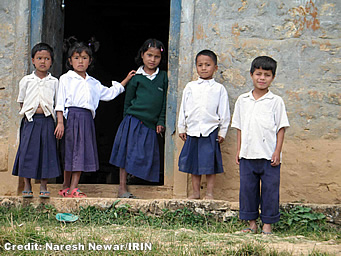 |
| Hunger
and poor diet among children continue to be a key reason for truancy in
many remote villages in west Nepal, according to local non-governmental
organisations (NGOs) working in the education sector.
"Food
shortages have always been the cause of children not being able to attend
school regularly," said schoolteacher Anil Srivastava, who teaches in the
government-run Shri Gayatri primary school in Tapri village, Bardiya District,
nearly 700km southwest of Kathmandu. |
|
Tapri
is the poorest village in poverty-stricken Bardiya District with most of
its people living on less than US$1 a day, according to Dalit Sewa Sangh,
a local NGO which focuses on helping rural communities.
Srivastava
explained that Tapri villagers, like many others in west Nepal, are unable
to produce sufficient food, and cannot afford to buy food for their children
either.
"How
can they continue to attend class when they are hungry all the time?" asked
Bijaya Ghimire, a schoolteacher. Bijaya said on average 10-15 percent of
students aged 10-14 in the area drop out every year before completing primary
school.
Tapri's
situation is typical of many remote villages in the country, where 14.5
percent of primary level students in grades 1-5 drop out every year, according
to the Ministry of Education.
Poor
facilities at school, long walking distances to school and lack of road
access have combined with poverty and hunger among children in remote areas
to exacerbate the problem, according to NGOs.
| Over
a million children out of school |
 |
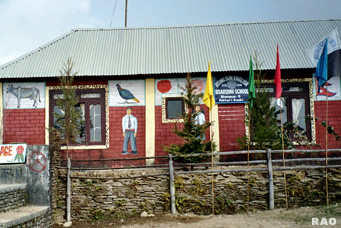 |
| "How
can we ever motivate parents to send their poorly fed children to school?"
asked schoolteacher Himalaya Prasad Adhikari. Teachers often get blamed
for failing to keep children at school, but the real reason has always
been poverty and food insecurity, Adhikari said.
"Food
is the answer to their regular attendance but we can't afford that," said
Adhikari.
Many
teachers working in rural schools in remote villages in west Nepal have
told IRIN that if the current situation continues it will be impossible
to increase enrolment in schools. |
|
Nepal
has an estimated six million children aged 5-14, according to the government's
Central Bureau of Statistics (CBS), and nearly 20 percent of them have
never enrolled in schools, especially in rural areas where 80 percent of
the population lives.
top
| "The
beginning of a child's destruction" |
 |
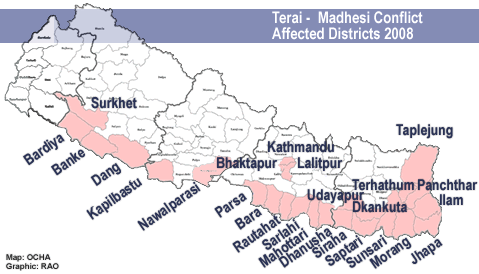 |
| "Dropping
out of school is merely the beginning of a child's destruction, as one
can never attend school [again], and [they] will start working or get married
at an early age," said Prem Yadav, a schoolteacher in Tapri.
Yadav
said the problem is worse for girl students who, after dropping out of
school, either get married or start working at an early age to support
themselves and their families. |
|
Most
boys migrate to cities and towns in both Nepal and India and never return
to school, said Yadav.
"Parents
often ask us what they will get in return for sending their hungry children
to school. We just have no answers," said Yadav. Until there is enough
food or there is an improvement in their extreme poverty situation, over
a million children will continue to be out of school, he said.
Credit
IRIN 2007
Copyright
Ⓒ UN Office for the Coordination of Humanitarian Affairs 2007
[
This report does not necessarily reflect the views of the United Nations]
Integrated
Regional Information Networks (IRIN), part of the UN Office for the Coordination
of Humanitarian Affairs (OCHA). |
 |
top
|
Links
|
 |
 |
 |
Externe
Links |
 |
| more information |
 |
|





